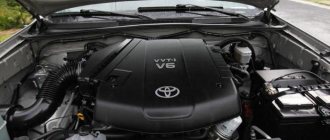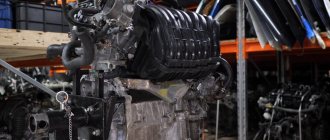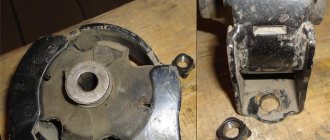3S-FE is a fairly common engine, the most popular in its series. This engine was equipped with many Toyota models (Avensis, Caldina, Carina, Celica, Corona, Nadia, etc.) from the mid-80s to the early 2000s. In this material we will analyze the operation of the 3S-FE idle air sensor, the procedures for dismantling and cleaning, as well as some nuances of adjusting the 3S-FE idle air valve.
Idle system 3S-FE
The idle speed sensor (or valve, as it is also called) on an internal combustion engine is designed to regulate the speed of the car engine while idling. The adjustment occurs by changing the amount of air entering the cylinders through an additional channel (“bypass”, bypass channel), bypassing the closed throttle valve. The amount of incoming air is taken into account by the air flow mass sensor. In turn, this information is sent to the engine control unit, which controls the supply of the appropriate amount of fuel.
Thus, the engine maintains constant speed in idle mode. The channel capacity is determined by the location of the valve spool, which is driven by the coils (solenoids) of the XX regulator. The magnetic field they create allows you to deflect the spool to the angle required for normal operation of the motor.
In case of failure of the electromagnetic element of the system, a mechanical method is provided to open the channel. The main elements of this mechanism are a spring (bimetallic spiral) and a valve lever. The special properties of the spring allow it to respond to the temperature of the liquid in the cooling system, changing its stiffness. Thus, the position of the stop and the angle of installation of the spool change. In this situation, the engine idle speed will be increased. It turns out that the spring duplicates the functions of the 3S-FE engine idle speed sensor, so that in case of failure the car does not stall.
Removing the air filter
It is also worth considering that a change in spring stiffness is caused solely by a change in coolant temperature. Therefore, unlike a working XX sensor, it cannot respond to connections to the on-board consumer network. When checking the adjustment of this mechanism, you should pay attention to the speed (with the DXX connector disconnected, it should be 1000-1200 rpm).
Diagnosis of IAC
Ideally, diagnostics of the regulator should be carried out on a stand that can reproduce the pulses of the on-board computer. In practice, this is expensive; low-cost verification methods are used. In any case, the algorithm of actions at the initial stage is the same:
- the handbrake is applied, anti-recoil devices - shoes - are installed under the wheels;
- disconnect the “-” terminal from the battery;
- knowing where the TPS and MAF sensors are located, the location of the IAC is determined;
- the valve is disconnected from the on-board computer (the plug is pulled out of the connector).
Valve removal
Further steps differ for different verification methods.
Manual check
The simplest method for checking IAC in an electronic intake distribution system is manual diagnostics (an assistant will be required):
- the IAC plug is disconnected from the connector;
- two screws are unscrewed and the device is dismantled;
- the regulator is reconnected to the ECU, but remains in the hands of the master;
- The assistant starts the engine, at this time the rod should be completely retracted into the coils, then, having received an impulse from the computer, extend a certain distance.
Manual IAC check
In other words, the functionality of the stem is checked, the owner makes sure that this part is not bent or jammed inside the valve. However, this does not provide a 100% guarantee that this IAC modification fully complies with the controller ECU firmware. The needle extends, but by an unknown amount. In the first case, the connector is checked, in the second - the plug; the markings are only on the plug.
In the classic version of checking “from simple to complex,” this stage is the initial stage; then you should check the integrity of the wires and coils, the condition of the bypass channel, and needle wear. Only after these steps can you assemble a homemade stand with a pulsed voltage supply for comprehensive diagnostics of IAC.
Diagnostics with a multimeter
At this stage, you will need an IAC tester, which is checked with this device in two modes:
- ohmmeter - when connecting contacts C – D and A – B with the multimeter probes, the resistance should have a value of 40 – 80 Ohms, D – C and A – D should be equal to infinity;
- with a voltmeter - when the ignition is turned on, the voltage reaches 12 - 20 V.
proverka-testerom
Attention: the IAC adjustment is performed automatically by the on-board computer after each connection of the device plug to the connector. After dismantling, it is recommended to lubricate the bypass channel with WD-40 spray to clean it. This measure is preventive, even in the absence of contamination of the bypass channel, in the gap of which the regulator is located.
Pulse testing on a homemade stand
Since the stand costs 1,500 - 1,800 rubles, and the regulator 300 - 500 rubles, purchasing the device is not economically profitable for the average user. A simple circuit without microchips is shown below:
- it uses 6 V charging from any mobile device;
- plug blocks are commercially available;
- First you need to disconnect the IAC from the on-board controller, then check the stroke of the rod;
- a bright glow of the lamp in the diagram indicates a malfunction of the rod itself;
- If the lamp burns at the incandescent level, the unit is considered to be in good condition.
Diagram of the device for checking IAC
Using a cleaning agent will restore the functionality of the rod, but only if it is clogged. If this part is bent, the entire regulator will need to be replaced.
Dismantling
To remove the idle air valve on a 3S-FE, you first need to remove the air filter cover, after loosening the clamp and disconnecting the temperature sensor. Afterwards, remove the pipe leading to the throttle body, also loosening the clamp and pulling out the cable and hoses.
We release the pipe from the attached cables and hoses before removing
Remove the cable casing, loosen its fastening bolts, and then remove the coolant pipes (dismantle only when the engine is cool!) and the “vacuum” hose. Disconnect the chips from the idle speed sensor and the remote control position sensor, then unscrew the fastening bolts and nuts. Finally, we remove the idle speed sensor winding, and then the valve itself (pay attention to the gasket, try not to damage it).
Cleaning the needle and bypass channel
To provide access to valve parts, removal of the IAC is required using the following technology:
- disconnecting the block from the connector;
- cleaning the connector contacts and plug with a cotton swab soaked in WD-40;
- unscrewing screws with a curved screwdriver;
- removing the regulator to check the condition.
IAC cleaning
Attention: There is no need to disassemble the regulator, just spray the spring and rod with needle with WD-40 spray, wait for it to dry, and at the same time clean the throttle bypass channel.
The adjustment is made by the on-board network controller itself. However, for stable operation of the engine, you should check the distance from the mounting flange to the protruding needle cone. By default it should be 23 mm.
Cleaning the XX valve
To clean the 3S-FE idle valve, you will need a brush and an ordinary “carb cleaner” (carburetor cleaning fluid). The main contamination of the valve is carbon deposits (plaque) on its internal part. You can soak the valve in cleaning fluid for several hours.
Prepare plugs to prevent coolant leakage
After the procedure, rotation of the valve should be very easy and unimpeded. At the same time, it is worth cleaning the throttle mechanism: there is no need to disassemble it. After moistening with cleaning liquid, carefully clean the unit with a rag or toothbrush. Assembly is carried out in reverse order. Before screwing it into place, it is worth applying a thin layer of sealant to the electromagnet.
Reasons for floating speed of Toyota Camry
An engine is not like a suspension or braking system that you can always repair yourself. Finding out the cause of a motor malfunction is much more difficult than any other component. Therefore, first of all, you need to contact a trusted specialist.
Reasons for the appearance of floating speed of the Toyota Camry:
- idle air control is broken;
- The low pressure pump does not work stably;
- engine troits;
- malfunction of injectors, spark plugs;
- flow meter is broken;
- air enters the fuel system;
- the air filter is clogged;
- the fuel system and filters are dirty;
- broken engine temperature sensor;
- The crankshaft sensor does not work;
- incorrect operation of the control unit;
- electrical wiring is faulty.
Settings
If the car's speed fluctuates at idle, or even more, the car simply stalls at idle, or the speed is too high, you should think about adjusting the idle speed sensor. Since his work is closely related to BDZ, it is necessary to start with him.
Remote sensing position
First you need to pay attention to the gap between the throttle drive stop and the stop screw. There should be no gap in the closed position of the damper. Please note that this screw does not regulate engine idle speed, but simply prevents wear on the damper.
Disconnect the chips and unscrew the DZ mounting bolts
Don't be surprised if you find the screw head sawed off. Many vehicles have this installed from the factory. A serviceable and adjusted damper moves smoothly, without jerking when starting, and does not require additional forces when pulled from its place.
Throttle position sensor
The throttle position sensor can be adjusted without removing it.
- loosen the fastening bolts;
- use a 0.7 probe to connect to contacts IDL – E2;
- by gently tapping with a hammer, you need to catch the moment when the resistance on the multimeter is equal to infinity (that is, the conductivity disappears);
- tighten the bolt of the upper sensor mounting, check everything according to the manual;
- tighten the bottom bolt and carry out a control check with all probes on all contacts.
Idle valve
It is worth noting that the resistance at the IDL – E2 contacts in itself does not matter, the main thing is that it does not exceed the permissible limit according to the manual (2.3 kOhm).
Spring adjustment
On the 3S-FE engine, the idle air valve is designed in such a way that the “shutter” can be opened either by an electromagnetic solenoid or by a spring, without the use of electronics. As already noted, this was done so that in the event of a failure of the electric mechanism, the engine does not stall, but continues to operate at idle.
For the spring to fire properly, it must be installed correctly. To check the correct operation of the spring, you need to disconnect the idle speed sensor chip. If installed correctly, the engine will maintain speeds of 1000-1200, and not 700-800, as when the electronics are running. This happens due to the inability of the spring to adjust the amount of air supplied depending on the load on the engine. This creates a power reserve in case electrical equipment is turned on (lights, cooling fan, etc.). Accordingly, as the load increases, the engine speed will decrease.
Spring
The spring must be set in such a way that without a solenoid it maintains the required 1000-1200 revolutions, there are no more tricks here. The most convenient way to adjust:
- warm up the engine to operating temperature;
- turn off the engine and remove the coil;
- loosen the spring bolts and start the engine;
- select and install the spring position corresponding to a speed of 1050-1150 rpm;
- tighten the fastening bolts and secure the coil in place;
- adjustment is complete.
The effect of malfunctions on engine operation and repair methods
Idle speed control
A broken idle speed control is a guarantee that the car's speed will start to fluctuate. The regulator's job is to open a bypass channel through which air flows. If it becomes clogged, the electromagnetic drive begins to jam, which means the idle speed will fluctuate. The solution to the problem is to replace the regulator or flush it, depending on its condition.
Low pressure pump
A faulty low pressure pump can cause unstable speed. But, unlike the case with the regulator, the speed will increase or decrease not constantly, but periodically. And the engine will perform worse at the start, when starting the engine and for the first 2-3 minutes. The symptom is accompanied by a loss of power and the appearance of black, blue or white smoke from the exhaust pipe.
Insufficient compression
There are many reasons for engine tripping. First of all, specialists check the compression in the cylinders. If it is insufficient or the readings differ in different operating spaces, this can cause unstable operation at idle.
Failure of spark plugs or injectors
Unstable engine operation can be caused by faulty spark plugs or poor injector performance. The injectors are checked on a stand. If a malfunction is detected, they are cleaned or replaced. Injector life is 15-30 thousand km. Spark plugs in a gasoline engine must be replaced after the same mileage.
Flow meter failure
The Camry 40 flow meter has been used in a car for no more than 10 years. If it fails, the rotation speed of the engine crankshaft begins to change, making it difficult to start the car. Unlike other faults, a flow meter breakdown is quite easy to check. By disabling the part chip, you can understand whether it is to blame for the floating speed. Stable operation after shutdown will indicate that it is faulty.
Air entering the fuel system
The fuel system of a diesel engine is characterized by low stability when exposed to air. If such a deficiency appears, the motor begins to overheat. Eliminating a system leak means eliminating a deficiency. Sometimes it is enough to tighten the intake manifold bolts.
Clogged filters
Interruptions in engine operation and, as a result, floating speeds can occur when the filter elements are clogged. Their premature clogging occurs when using low-quality fuel. This can also cause clogging of the fuel system. In this case, unstable operation will manifest itself on an unheated engine, and when the operating temperature increases, everything will return to normal.











